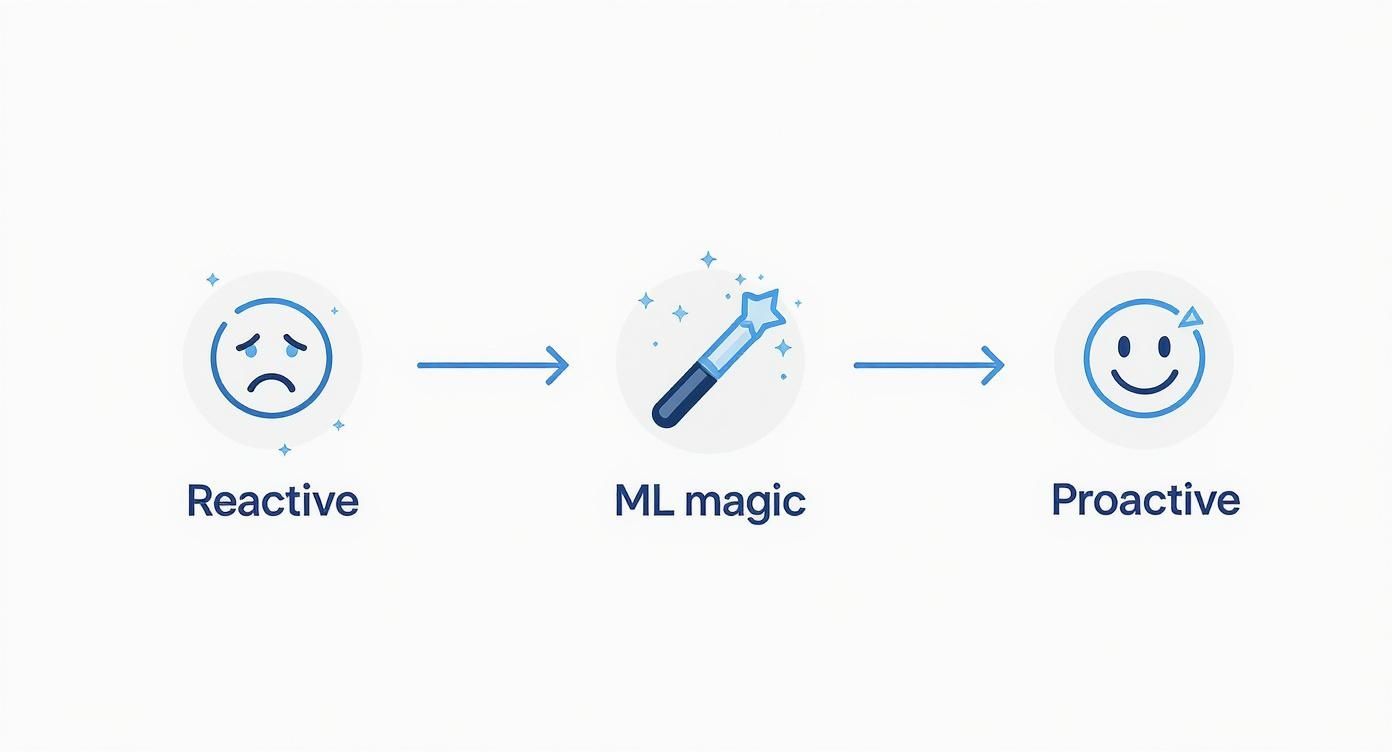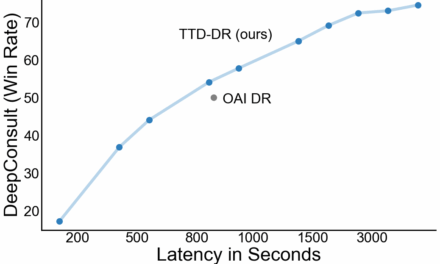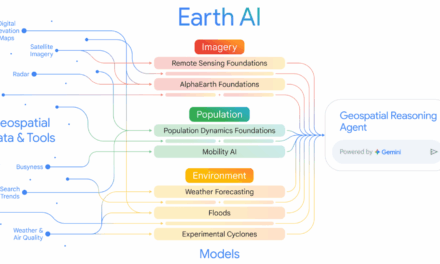Let's cut through the tech jargon and get straight to what business machine learning really is. In simple terms, it's about teaching your computer systems to learn from your own business data. The goal? To make incredibly smart predictions and decisions that drive real results, kind of like giving your business a crystal ball powered by data.
Think of it as the ultimate business analyst, one that can sift through mountains of information to find hidden patterns and forecast what's coming next. This allows your company to stop just reacting to market changes and start proactively shaping its own future.
What Is Business Machine Learning Anyway?
You already see this in action every day, even if you don't realize it. Ever wonder how Spotify's "Discover Weekly" playlist seems to know your music taste better than you do? That's a perfect example of machine learning. The algorithm studies your listening habits, identifies patterns, and predicts other songs you’re almost guaranteed to love.
Business machine learning takes that same powerful logic and applies it to your company's core operations. It just swaps out song data for your sales figures, customer service tickets, and supply chain logistics.
This predictive power is the key difference between modern machine learning and traditional business analytics. Analytics is great for telling you what happened last quarter; machine learning uses that same data to forecast what's likely to happen next quarter. It’s a genuine shift from hindsight to foresight. For a deeper dive into the mechanics, our guide on what is machine learning is a great place to start.
From Reporting The Past To Predicting The Future
Think about the standard way of doing things. A sales manager pulls up a dashboard to review last month's numbers. It's useful information, for sure, but it’s like driving while looking only in the rearview mirror. You know where you’ve been, but not where you’re going.
Business machine learning completely changes the game. It creates a dynamic model that learns from all of your historical sales data—the wins, the losses, the near misses—and applies those lessons to your current pipeline.
"Instead of just reporting that we lost 5% of customers last year, machine learning can predict which specific customers are at high risk of leaving in the next 30 days, giving you a chance to intervene." – Dr. Eva Chen, AI Strategist
This isn't just a small tweak to your process; it's a fundamentally new way to operate. It empowers you to get ahead of problems, spot opportunities before your competitors do, and make critical decisions based on what’s likely to happen, not just what already did.
Machine Learning vs Traditional Business Analytics
To really nail down the difference, it helps to see them side-by-side. Traditional analytics has served businesses well for decades, but machine learning opens up a whole new set of possibilities.
| Aspect | Traditional Business Analytics | Business Machine Learning |
|---|---|---|
| Primary Goal | Describing what has happened (descriptive). | Predicting what will happen (predictive). |
| Data Focus | Uses structured, historical data. | Uses structured and unstructured data to learn patterns. |
| Key Question | "What were our sales last month?" | "Which customers are most likely to buy next month?" |
| Output | Static reports, dashboards, and visualizations. | Dynamic models that adapt and improve over time. |
| Human Role | Humans interpret data and make decisions. | Humans oversee models that recommend or automate decisions. |
| Time Horizon | Backward-looking (hindsight). | Forward-looking (foresight). |
Essentially, analytics gives you a clear picture of the past, while machine learning gives you a data-driven roadmap for the future.
This Is Quickly Becoming The New Standard
This forward-looking approach is no longer a niche strategy; it's rapidly becoming the baseline for competitive businesses. The explosion in AI adoption has completely reshaped workflows, with a staggering 71% of companies reporting generative AI use in 2024—nearly double the rate from the previous year. You can dig into these growing AI adoption trends to see just how quickly the business world is embracing these new capabilities.
How Machine Learning Creates Real Business Value

It’s one thing to understand the theory behind machine learning, but the real magic happens when you see what it can actually do for your bottom line. Forget the futuristic robots for a moment. In the business world, machine learning is all about solving very real, everyday problems with a level of speed and accuracy that was once impossible.
Instead of just reacting to historical reports or relying on a hunch, you can use your own data to get ahead of the curve. Machine learning is brilliant at finding the hidden signals and subtle patterns buried in your operations, turning a sea of abstract numbers into clear, actionable intelligence.
Solving Problems You Already Have
Machine learning is at its best when aimed at a specific, tangible challenge. It gives you a structured way to answer critical business questions that used to be too complex to even approach. Think of it as a super-powered assistant for three main types of tasks.
Here are the kinds of challenges where business machine learning really shines:
- Forecasting Future Demand: A retailer, for instance, can stop guessing how much inventory they'll need for the holiday season. A machine learning model can analyze past sales, market trends, and even weather patterns to give a surprisingly accurate prediction. No more dusty boxes of unsold stock or running out of a hot item.
- Classifying Data Intelligently: This is all about sorting things into the right buckets. For an e-commerce store, that could mean automatically classifying customer support tickets by urgency ("urgent order issue" vs. "general question") or flagging financial transactions that look fraudulent. It saves time, money, and a lot of headaches.
- Optimizing Complex Processes: A delivery company can use ML to analyze thousands of variables—traffic patterns, delivery windows, truck capacity—to map out the most efficient routes for its drivers, cutting down on fuel costs and delivery times.
By focusing on these core functions, you start to see how this technology moves from being a buzzword to a practical tool that drives real efficiency and growth.
"The magic of machine learning in business isn't just its predictive power, but its ability to automate thousands of micro-decisions. Identifying the perfect starter project is about finding a high-volume, repetitive decision-making process and teaching a machine to do it better and faster than a human ever could." – David Lee, Lead Data Scientist
This really gets to the heart of it: start small. You don't need to overhaul your entire company overnight. Find one bottleneck—one repetitive, data-heavy task—and apply machine learning there first. Scaling AI across an organization is a journey, and starting with a clear, measurable win builds the momentum you need. For a great look at this process in action, check out how BBVA is scaling AI from pilot to practice.
From Abstract Concepts To Concrete Wins
Let's make this even more practical. Here are a couple of real-world scenarios that show how machine learning translates directly into tangible business value.
Example 1: A Local Coffee Shop
- The Challenge: The owner is constantly wrestling with food waste. They either bake too many pastries on slow days or run out during a surprise rush, losing sales.
- The ML Solution: A simple forecasting model is built using past sales data, the local event calendar, and weather forecasts.
- The Result: The model starts predicting daily demand with over 90% accuracy. The shop cuts its food waste by 40% and increases sales by always having its most popular items in stock.
Example 2: An Online Clothing Retailer
- The Challenge: The marketing team blasts the same promotional email to every single customer, leading to abysmal open rates and a growing unsubscribe list.
- The ML Solution: A classification model segments customers based on their purchase history, browsing behavior, and past email engagement.
- The Result: The retailer now sends highly targeted promotions—like a special offer on running shoes only to customers who have previously bought athletic wear. This simple change increases email engagement by 200% and gives conversion rates a healthy boost.
The impact of this technology is undeniable and growing fast. The machine learning market is projected to expand at an incredible 34.8% compound annual rate between 2025 and 2030. Within companies already using it, the value is spread across departments: 38% of the impact is felt in support operations, 23% in core operations, and 20% in marketing and sales. This shows that businesses aren't just experimenting anymore; they're seeing real, measurable returns on their investment.
Practical Applications of ML Across Your Business
Theory is one thing, but seeing machine learning in action is where the real magic happens. This isn't some futuristic concept anymore; it's a tool businesses are using right now to solve real problems and get ahead. We're talking about moving from abstract strategies to specific, data-powered actions that make a tangible difference every single day.
Let's walk through a few departments in a typical company to see how machine learning is already reshaping the way they work.
Supercharging Your Marketing and Sales Engine
Marketing has always been a mix of art and science, but machine learning is tipping the scales heavily toward science. It gives teams the power to stop guessing and start creating genuinely personal experiences for customers.
Before ML: The team blasts out the same generic email to everyone on their list, crossing their fingers that something sticks. Engagement is pitiful, and the sales team wastes hours chasing down cold leads that go nowhere.
After ML: Now, a lead scoring model sifts through data from past wins to rank new leads, showing the sales team exactly who to call first. At the same time, the website's recommendation engine acts like a personal shopper, showing customers products they’re highly likely to love—just like Netflix queues up your next binge-worthy show.
This creates a far more efficient and effective process from top to bottom. Instead of shouting into a crowd, you're having a meaningful conversation with the right person at just the right moment.
"Predictive analytics is one of the most powerful tools in modern business. Instead of just reacting to churn after you’ve lost a customer, ML models can identify at-risk customers before they leave, giving you a crucial window to win them back with targeted offers or support." – Maria Rodriguez, VP of Customer Success
This proactive approach completely flips the script on the customer relationship, turning a potentially negative moment into a chance to build even stronger loyalty.
Fine-Tuning Your Operations and Logistics
On the operations side of the house, efficiency is the name of the game. Machine learning is brilliant at optimizing complex systems, finding those tiny improvements that snowball into massive savings in time, money, and headaches.
Before ML: A factory follows a rigid, calendar-based maintenance schedule, replacing parts whether they need it or not. Their supply chain is just as rigid, relying on static forecasts that lead to either overstocked warehouses or frustrating "out of stock" notices for customers.
After ML: Now, sensors on the factory floor feed data into a predictive maintenance model. The system flags a machine for service days before it's projected to fail, preventing expensive, production-halting downtime. Meanwhile, a demand forecasting model is busy adjusting inventory levels in real-time, factoring in everything from current sales data and weather patterns to social media buzz.
Making this shift from a reactive to a predictive operational model is a total game-changer. It ensures resources are used precisely where and when they're needed most.
Guarding Your Finances and Slashing Risk
In the world of finance, every second and every decimal point matters. Machine learning models can analyze thousands of transactions in the blink of an eye, spotting anomalies a human could never catch and building a powerful defense against financial threats.
Before ML: A fraud detection team relies on a clunky, rules-based system to flag suspicious activity. It's slow, spits out a ton of false positives (annoying legitimate customers), and is always a step behind the latest scam tactics.
After ML: A sophisticated fraud detection algorithm learns the unique patterns of normal customer behavior. The moment a transaction deviates from that pattern—like a purchase from an odd location at 3 a.m.—it's instantly flagged for a closer look. This not only stops more fraud in its tracks but also dramatically reduces the number of good transactions that get blocked by mistake.
Common Business Machine Learning Applications
To pull it all together, here’s a quick look at how these applications show up across different business functions, driving concrete results.
| Department | ML Application Example | Business Outcome |
|---|---|---|
| Marketing | Personalized product recommendations and content. | Increased customer engagement, higher conversion rates, and improved loyalty. |
| Sales | Predictive lead scoring to identify high-potential prospects. | Improved sales team efficiency and higher close rates. |
| Operations | Predictive maintenance for equipment and machinery. | Reduced equipment downtime and lower maintenance costs. |
| Finance | Real-time anomaly detection for financial transactions. | Drastically reduced financial losses due to fraud and fewer false positives. |
| Customer Service | AI-powered chatbots to handle common inquiries. | Faster response times, 24/7 availability, and reduced workload for human agents. |
This isn't just a trend for a handful of tech giants anymore; it's a mainstream business reality. As of 2025, business adoption of AI has soared, with 87% of large enterprises having put AI solutions to work. These companies are investing an average of $6.5 million each year, with a whopping 76% of them targeting process automation first. You can explore the latest AI adoption statistics for enterprises here. The bottom line is clear: this is no longer about experimenting—it's about fundamentally rethinking how business gets done.
A Simple Framework for Your First ML Project
Jumping into your first business machine learning project can feel like trying to assemble a spaceship without a manual. The terminology is complex, the process seems intimidating, and it's hard to know where to even begin.
But here’s the good news: you don't need to be a rocket scientist. A successful project follows a surprisingly logical and approachable path. The key is to think of it not as a giant technological leap but as a series of manageable steps, each with a clear purpose.
Let's break down a simple, five-stage framework that demystifies the whole thing. This isn't about dense math; it's about asking the right questions and focusing on the business problem you want to solve.
The journey fundamentally shifts your business from being reactive to proactive, moving from putting out fires to preventing them in the first place.

Stage 1: Start With Your Why
Before you touch a single data point, the most crucial step is to define the business problem you're trying to solve. So many projects fail because they start with a cool technology and then hunt for a problem. Flip that script.
Start by asking simple, powerful questions about your operations:
- What is the biggest bottleneck we face right now?
- Which repetitive task consumes the most staff hours?
- Where are we leaking money or missing obvious revenue opportunities?
A great first project is small and specific. Instead of a vague goal like "improve marketing," a much better target is "predict which of our current customers are most likely to unsubscribe in the next 60 days." That’s measurable, specific, and has clear business value.
Stage 2: Gather and Prepare Your Data
Here's where the real work begins. Data is the fuel for any machine learning model, and the quality of that fuel determines how well your engine will run. It’s a classic case of "garbage in, garbage out."
Don't be surprised if this stage takes up the most time—sometimes as much as 80% of the entire project. Your goal is to collect all the relevant information and get it into a clean, consistent format that a model can actually understand.
This usually involves:
- Collecting Data: Pulling information from your CRM, sales records, website analytics, and customer support tickets.
- Cleaning Data: Fixing typos, filling in missing values, and removing duplicate entries. It's the digital equivalent of tidying up.
- Formatting Data: Making sure all your information is consistent, like ensuring all dates are in the same
MM-DD-YYYYformat.
Think of it like a chef preparing ingredients before cooking. You wash the vegetables, chop everything to the right size, and lay it all out. A disorganized kitchen leads to a messy meal; disorganized data leads to an inaccurate model.
Stage 3: Choose and Train a Model
Now for the fun part. With your clean data ready, it's time to select a machine learning model and train it. The good news is, with modern tools, you don't need a Ph.D. in statistics to get started.
Think of this like choosing the right tool for a job. If you need to hang a picture, you grab a hammer, not a wrench. Similarly, if you want to predict a number (like next quarter's sales), you might use a regression model. If you want to sort things into categories (like "fraudulent" vs. "not fraudulent"), you'd use a classification model.
Training the model is the process of feeding it your prepared data and letting it learn the patterns. The model analyzes thousands of examples and starts to build its own internal logic for how different inputs lead to specific outcomes.
Stage 4: Evaluate the Results
Once your model is trained, you need to check its homework. How accurate is it, really? This evaluation stage is critical for building trust in your new system.
To do this, you test the model using a separate set of data that it has never seen before. This prevents the model from simply memorizing the training data. If your model correctly predicts customer churn on the test data 95% of the time, you can be confident it has learned the underlying patterns and isn't just "cheating on the test."
This step is your reality check. It’s where you prove to yourself and your stakeholders that the model is genuinely useful and not just a statistical fluke. Don't get discouraged if the first version isn't perfect; this is an iterative process of refinement.
Stage 5: Deploy and Monitor
Finally, it's time to bring your solution to life. A machine learning model sitting on a data scientist's laptop doesn't provide any business value. Deployment is the process of integrating your model into your actual business workflows so it can start making predictions in the real world.
This could mean a few different things:
- A new dashboard that shows your sales team a "likelihood to close" score for each lead.
- An automated alert that flags potentially fraudulent transactions for your finance team.
- A backend system that personalizes product recommendations on your website in real-time.
But the work doesn’t stop there. Once deployed, you must monitor the model's performance. The world changes, customer behavior shifts, and a model that was accurate last year might become less so over time. Continuous monitoring ensures it remains effective and keeps delivering value.
To get a better handle on this final, crucial step, you can explore our detailed guide on best practices for machine learning model deployment.
Navigating Common Challenges and Misconceptions
Getting into business machine learning is exciting, but it’s not a magic bullet. It’s a serious business strategy, and like any strategy worth pursuing, it has its fair share of hurdles and myths. Knowing what you're up against from day one helps you set realistic expectations and avoid the common traps that trip up even the most promising projects.
Let's get real about the challenges you'll likely face and debunk a few of the biggest myths that keep floating around.
Facing the Practical Hurdles
Putting machine learning to work isn't just about picking a cool algorithm. The real work is in navigating the messy realities of data, people, and processes. These are the top three roadblocks nearly every company hits.
-
The 'Garbage In, Garbage Out' Problem: This is the first, and most important, rule of machine learning. Your model is only ever as good as the data it learns from. If your data is messy, incomplete, or just plain wrong, your results will be unreliable at best—and dangerously misleading at worst. Many projects stall right here because teams wildly underestimate the effort it takes to get their data into shape before the fun part even starts.
-
Finding the Right Skills: You don't need a whole department of Ph.D.s, but you do need people who get both your business and the fundamentals of data. That specific mix of skills is harder to find than you'd think. The challenge isn’t just about hiring a data scientist; it’s about building a data-curious culture where your whole team feels comfortable asking the right questions.
-
The Pressure to Prove ROI: Machine learning projects take time and money upfront. Naturally, your stakeholders will want to see a return on that investment. The pressure is always on to get past a neat "proof of concept" and deliver something that actually moves the needle—whether that’s making things more efficient, bringing in more revenue, or cutting costs. The smartest way to handle this is to start with a small, high-impact project to get a quick win on the board and build momentum.
Busting Common ML Myths
Beyond the practical stuff, a lot of myths and misunderstandings can either scare people off or create wildly unrealistic expectations. Let’s clear the air.
"Many leaders think of machine learning as a magic wand that can solve any problem. In reality, it's more like a powerful tool that requires a skilled operator. The most critical skill isn’t technical—it's having strong data governance. A clear strategy for managing data quality, access, and security is the true foundation of any successful ML initiative." – Priya Singh, Chief Data Officer
This is spot on. Success doesn't start with fancy tech; it starts with a solid, well-managed data foundation.
Here are a few myths that really need to go away:
-
Myth 1 "You Need Google-Sized Data": This is a huge one. Sure, some problems require absolutely massive datasets (like training a giant language model), but most business problems don't. A model for segmenting your customers, for example, might only need a few thousand clean records to uncover powerful insights. Quality and relevance will always beat sheer quantity.
-
Myth 2 "AI Will Replace Everyone's Job": That's the plot of a sci-fi movie, not a realistic business plan. Machine learning is much more likely to augment human jobs than eliminate them. It’s brilliant at taking over repetitive, data-heavy tasks, which frees up your people to focus on strategic thinking, creative problem-solving, and building relationships—all the things humans are uniquely good at.
-
Myth 3 "It's a One-and-Done Project": A machine learning model isn't software you just install and forget about. Think of it as a living system that needs regular check-ups. Customer behavior changes, markets shift, and your model’s accuracy will drift if it isn’t retrained with fresh data. Real success in business machine learning is an ongoing cycle of improvement, not a project with a finish line.
Your Actionable Next Steps into Machine learning
Feeling inspired and ready to make a move? The journey into business machine learning can feel intimidating, but getting started is more straightforward than you might think. The trick is to begin with a clear focus and build from there, regardless of your team's technical expertise.
The best way to dip your toes in is by identifying a small but high-impact problem. What are the repetitive, manual tasks that drain your team's energy? Where are the operational bottlenecks that consistently cause headaches? A great first project doesn’t try to solve everything at once; it hones in on one specific issue with a measurable outcome.
Find Your First Win
Don't aim for a massive, company-wide overhaul right out of the gate. Instead, look for a quick victory that builds confidence and proves the concept.
-
Marketing: Instead of rethinking your entire customer journey, build a simple model to predict which customers are most likely to open a promotional email.
-
Operations: Rather than overhauling the whole supply chain, focus on forecasting demand for just your top 10 best-selling products.
This approach keeps the stakes low and gives your team a clear, focused objective to rally around.
"The magic of a first project is proving that this isn't just theory. When you show your team that a small, focused machine learning model can save them five hours of manual work a week, you create believers and build the momentum needed for bigger initiatives." – An expert on ML adoption
Empower Your Team with the Right Tools
You don't need to hire a full team of Ph.D. data scientists to get started. Many of today's ML platforms are designed for business users, with friendly interfaces that do the heavy lifting behind the scenes. Look for tools that offer "no-code" or "low-code" options, which let your team experiment with data without writing a single line of code.
Perhaps the most important step you can take, though, is to foster a data-curious culture. Encourage your people to ask questions, spot patterns, and think critically about the numbers they see every day. This shift in mindset is often more powerful than any piece of software.
The takeaway is simple: business machine learning isn't just for tech giants anymore. It's an accessible tool that, when applied thoughtfully, can become your company’s next great competitive edge. With these practical first steps, you have a clear path forward.
Frequently Asked Questions
Diving into business machine learning can feel a bit like learning a new language. You hear all these powerful concepts, but the practical starting point isn't always clear. Let's break down some of the most common questions people have when they're just getting their feet wet.
Do I Need a Team of Data Scientists to Start?
Not at all. While having a dedicated data science team is great for massive, complex projects, it's definitely not a requirement for getting started. Many businesses get their first wins by using accessible, cloud-based ML platforms from providers like Google, AWS, or Microsoft.
You can often kick things off with a single tech-savvy person on your team who really knows your data. Another great option is to hire a consultant for a short-term project. The goal is to start small, prove the value with a clear victory, and then build out your team and tech stack once you've seen what's possible.
How Much Data Do I Really Need to Begin?
This is a huge misconception—the idea that you need "big data" from day one. The truth is, the amount of data you need is tied directly to the problem you're trying to solve. For something like grouping customers based on their buying habits, a few thousand clean, well-structured records might be all it takes to uncover some game-changing insights.
On the other hand, if you're trying to train a model to recognize specific objects in images, you're going to need a much, much larger dataset.
The golden rule of business machine learning is that data quality is far more important than data quantity. Focus on gathering high-quality, relevant data for one specific business problem first. A small, clean dataset will always outperform a massive, messy one.
What Is the Biggest Mistake to Avoid When Adopting ML?
Hands down, the single biggest mistake is falling in love with the technology before you've identified a business problem. It's easy to get caught up in the hype of "doing AI" without a clear purpose. This tech-first approach is a recipe for a project that costs a lot and delivers very little.
Every successful business machine learning project starts with a business question. Get specific and frame your goals around real-world outcomes, like:
- How can we reduce customer churn by 10% in the next quarter?
- Which of our sales leads are most likely to actually buy something?
- Can we automatically sort incoming customer support tickets to speed up response times?
Lead with the value you want to create. The technology is just the tool you use to get there.
Ready to turn AI theory into practical business results? At YourAI2Day, we provide the latest news, expert insights, and practical guides to help you make smarter decisions. Explore our resources and start your journey today. Learn more at https://www.yourai2day.com.





